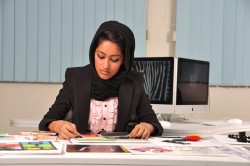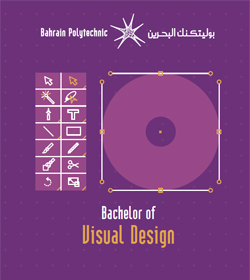- 8 Semesters (Full-Time) – 480 credits
Programme Entry Requirements
- Applicants must achieve the minimum requirements in the English and Mathematics entry tests OR passing Maths and English courses in the Foundation programme.
- In addition, applicants must submit a portfolio of 10 to 20 examples that has a range of original, developmental and finished works. A portfolio may consist of any type of the student’s artistic work.
- If successful at portfolio review, the applicant will attend an interview where they will be chosen according to motivation, maturity, creativity and communication skills.
Course FeesApply Now Submit Visual Design Portfolio
Introduction and Programme Aims
 The Bachelor of Visual Design aims to deliver a successful and effective programme of study of which is distinctly “hands on” and highly interactive that has its foundations in the visual communication industry of today.
The Bachelor of Visual Design aims to deliver a successful and effective programme of study of which is distinctly “hands on” and highly interactive that has its foundations in the visual communication industry of today.
Students are encouraged to achieve excellence within their disciplined areas to inspire the growth of their cultural and aesthetic sensitivities; leading them to an understanding of those human factors so essential in the production of communication and information.
The programme’s goals are to develop a student’s awareness of global issues and of their role as a Visual Design graduate as a member of the international community.
Graduates will have a broad-based knowledge of the design industry with an understanding of, and capabilities within, their field of visual design. They will be able to adapt and apply skills such as research and critical thinking to situations of today.
To view the courses of this programme, please click on the link below.
Graduate Profile
On successful completion of this programme, students will have the skills and knowledge to be able to:
- Solve creative problems, take risks, challenge preconceptions, experiment and test ideas within the field of visual design including research and synthesis of technical, aesthetic and conceptual knowledge.
- Recognise the influence of major cultural and aesthetic trends, both historical and contemporary, in Visual Design
- Communicate clarity of purpose, appropriate selection of media with sensitivity to the needs of the audience in the production and presentation of ideas.
- Utilise a design approach to apply new ways of addressing contemporary issues that involve working with others, industry and community
- Manipulate image and typography accurately and cohesively in order to turn the client’s ideas into final output.
- Team work: Interact effectively with fellow designers or with those from different disciplines through collaboration, collective endeavor and negotiation
- Communication: Articulate ideas and information comprehensively in visual, oral and written forms through effective communication and presentation skills
- Technology: Utilise industry standard technology effectively and ethically
- Self-Management: Demonstrate the ability to study independently, set goals, manage their own work load and meet deadlines
- Problem Solving: Identify, critically analyse a problem, trouble-shoot, formulate and justify the most appropriate solutions.
- Initiative and Enterprise: Use strategic thinking to demonstrate resourcefulness, innovation and entrepreneurship in Visual Design.
- Planning and Organizing: Initiate, plan, execute and manage work efficiently and effectively
- Learning: Recognize the need to engage and progress with continuous learning
Career Opportunities
Bachelor of Visual Design graduates will be able to find work in a variety of areas including but not limited to:
- Advertising agencies.
- Animation industry.
- Graphic design consultants.
- Graphic design educator.
- Design studios.
- Newspaper industry.
- Packaging industry.
- Printing industry.
- Publishing industry.
- Self-employment.
- Tele-communications industry.
- Visual communication.
- Web design.
- Television.
- Games design.
- Photo journalism.
- Set design.
- Commercial photography.
- Exhibition design.
- Brand marketing.
- Interactive/haptic interface design.
- Type design.
- Corporate design.
Teaching and Assessment
Studio-based learning is practical in its nature and provides an environment that is characterized by diversity and multi-interactions. Courses are delivered primarily face to face through problem-based learning, which is supported by student-centered activities and hands on practical skills based lessons. Online learning as well as group discussions, videos, case studies and workshops will support the learning environment. Tutorials, independent research, and assignments will also be used. Assessments include presentations, briefs, group projects, reflective work, peer evaluations, client feedback, and research development.
Work Placement
During year 4 each student will be placed in a suitable design studio to gain more understanding of the private sector of the Visual Design Industry in Bahrain. Students will also participate in a group project for a local community not-for-profit organisation that is within the Visual Design arena. Both sections will have supervisors from the Polytechnic Bachelor of Visual Design Programme and from either the not-for-profit organisation or the chosen design studio.
Qualifications
- Bachelor of Visual Design
- Diploma in Visual Design
Accreditation and Partnerships
Bahrain Polytechnic will become a member of the Icograda Educational Network (IEN), a network of Art and Design schools around the world. This will enable students across design disciplines and cultures to raise awareness of the importance of design in the Gulf region.
Summary of Programme Structure
To be awarded a Bachelor of Visual Design degree, students must complete a four year programme of study consisting of 480 credits. Students may also exit with a Diploma in Visual Design upon achieving 240 credits which meet the specified requirements.
In the first two years, students will study several courses related to color theory, different typographies, historical studies in design, branding methods, and online media.
In their last two years, students will work on portfolio preparation and designs, design research, and project implementation. Students will have the opportunity to work on industry and community projects to prepare them for entry into the industry.
Specific courses being delivered in this programme can be found at the Polytechnic’s website under “Bachelor of Visual Design”.




